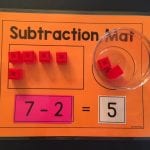by C. Elkins, OK Math and Reading Lady
In the previous post, I addressed problems dealing with an additive process (join; aka SSM). In this post, I will show you some models to use for these types of problems: Separate; aka Some, Some Went Away — SSWA. I will share some models which are great for KG stories as well as templates that are helpful for intermediate students to use, especially when dealing with missing addend types.
As I previously mentioned, it is my belief that students should focus more on the verb / action in the story and not so much with the key words we often tell kids to pay attention to. Brainstorm actions that signify a subtractive process. Post it in the class. Keep adding to it as more actions are discovered. With this subtractive action, kids should quickly realize that there should be less than we started with when we take something away. Here is a FREE poster showing some of the most common subtraction action verbs. Click HERE to get your copy.

Some of the work mats pictures below come from the following source. These are great for KG-2nd subtraction storytelling. Subtraction Pack: A Pinch of Kinder by Yukari Naka
Like with all story problems, I model how I reread the problem several times.
- First read — Just read it
- Second read –Identify who and what the story is about (the action).
- Third read — Decide what to do with the numbers. Is a given number the whole / total amount or part of the amount? Do I know how the story started? How it changed? The result?
Here are 3 types of subtraction story structures: Continue reading

